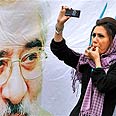
Woman power in Iran
Iranian women fed up with restrictions, play prominent role in protests
For years it was customary to measure the intensity of women’s protests in Iran by the extent to which their hair would stick out through their colorful veils. The more hair could be seen, the greater the demand was for freedom in the country.
During the wave of protest in the wake of the election results, Iranian women played a prominent role in images from the “front.” They were photographed marching alongside the men and struggling against security forces and militias.
The protest of women turned into a symbol after the video of Neda Sultani’s shooting death circulated worldwide. Even though Iranian culture lauds martyrdom, this glory is usually reserved for men, while leaving women with the role of the martyr’s mother or wife. In Neda’s case, the immense effort undertaken by authorities in a bid to prevent protestors from carrying her photos and stop her family from mourning her highlight the fact she has become a symbol for young Iranian protestors.
It appears that the elections and the struggle in their wake created an outlet for the anger of women across the Islamic republic. The government’s brutal response, which was manifested through hundreds of arrests, dozens of casualties, and severe limits on the media served to reinforce the displeasure among large sections of the population.
Beyond opposition charges of election fraud, the 35 million women in Iran have good reason to be angry. Many of them feel that another Ahmadinejad term in office would worsen their condition. They fear that the man elected in 2005 thanks to his pledge to reinstate “Islamic values” in Iran may continue to limit their rights.
Fashionable women risk arrest
During his first term in office, Ahmadinejad passed laws that made it difficult for women to work overtime, forcing many of them to work part-time. Last year, his government presented a bill aimed at making it easier for men to marry more women; a move that is customary within Islam yet stirs great anger in Iran. More than 60 pro-women activists were detained after taking part in a campaign aimed at collecting one million signatures in support of improving the status of women in Iran.
Yet more than anything else perhaps, women were hurt by the issue of dress. Ahmadinejad’s government strictly upheld Islamic dress codes, with women required to cover their hair and wear long and loose-fitting clothing to hide their figure; those who dared to be too fashionable risked arrest.
Although women in Iran cannot be elected for the presidency and for religious posts, there are quite a few women in parliament and they constitute 65% of university students. During the election campaign, a coalition of women from various strata made an effort to ensure that the various candidates will improve the status of women.
Mir-Hossein Mousavi gave them hope, as he maintains progressive views in respect to women’s affairs and ran an unusual campaign, with his wife appearing by his side (the first time this happens in Iran.) She appeared with him at election conventions, participated in TV ads, and even attacked his political rivals.
Now, we shall wait and see how Iranian women will be expressing their protests in the coming years, after Ahmadinejad - who is perceived as the man who limited their rights and may further worsen their condition - won a second term in office.










